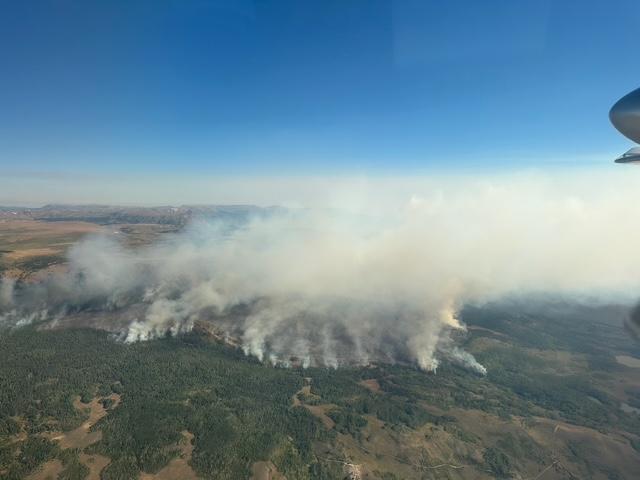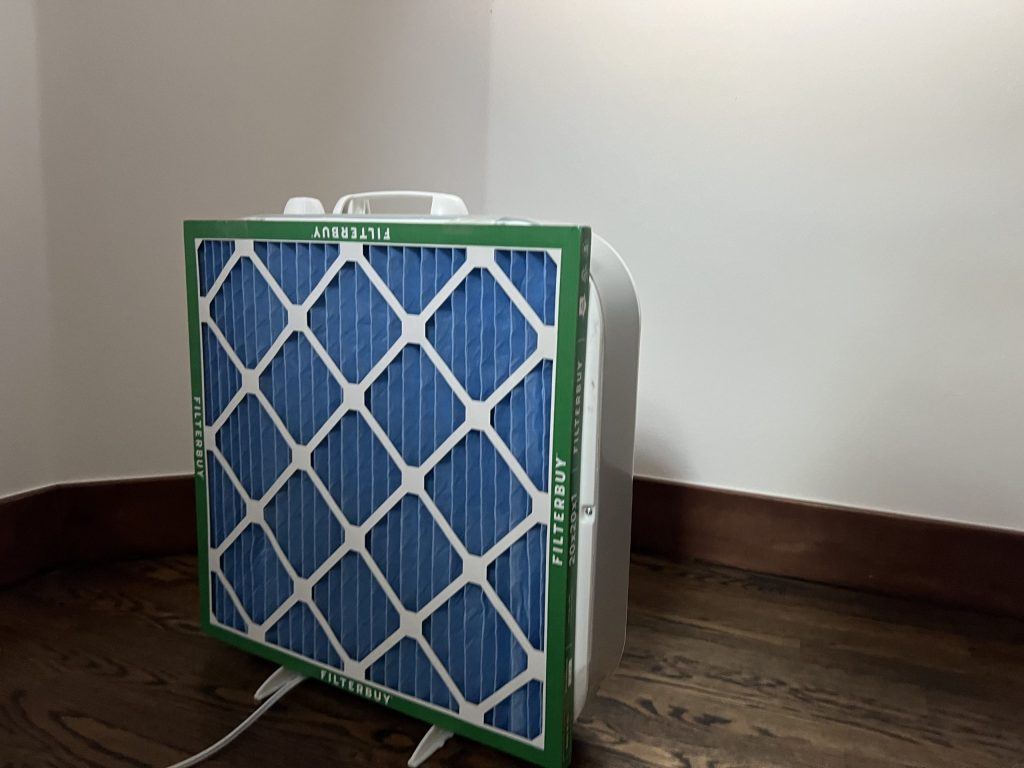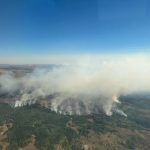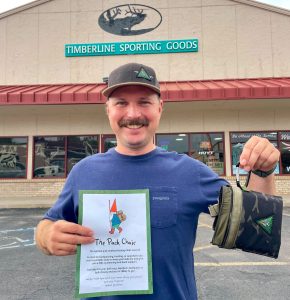How wildfire smoke impacts health
On hazy days, consider staying inside, and maybe building a DIY air filter

Inciweb/Courtesy photo
During wildfire season, every fire comes with the direct risk of what it burns. But there is a secondary risk that comes with all wildfires: The impact of smoke haze on human health.
Smoky air is a public health concern, said Kirk Weems, Eagle County’s environmental health specialist. “It’s not the ash in the air that we see falling that’s the hazard, it’s the really fine particulates,” he said.
“When you have smoky air, presumably from forest fires, it creates small particles,” said Dr. Joe Forrester, a pulmonologist at Vail Health. “The soot that we see are large particles, and those are near the fire … But if you’re a distance away and you can see the haze, and the haze is near you, then those are what is considered fine particles, and fine particles can affect the respiratory system.”
The small particles, measuring 2.5 micrometers or less in diameter, can “get into your bronchial tubes and the smaller bronchioles, and they can create irritation and inflammation and can create health problems in susceptible individuals,” Forrester said.
Most people will see limited short-term impacts from the smoke-related particulates, though throat and eye irritation, headaches and more can occur. But certain populations, including individuals with preexisting respiratory conditions, babies and elderly people, are at higher risk of experiencing health effects from the particulates.
“The risks are graded depending on how much of those fine particles you are exposed to and for how long you get exposed to them and then also the predisposition of the individual,” Forrester said. “If someone has underlying asthma, chronic bronchitis, a thing called bronchiectasis or chronically inflamed airways, they’re at risk to have an exacerbation of their underlying condition.”
How haze affects the body
“Your respiratory system is a pretty good filter. Most things that are soot or ash, you won’t be exposed to them,” Forrester said.
But particles measuring 10 micrometers in diameter and smaller can deposit along the bronchial tubes, causing inflammation, preventing the clearing of secretions and trapping allergens.
For at-risk individuals, this can affect breathing and trigger and worsen preexisting conditions.
“(Haze) has been correlated with increased emergency room visits for these individuals, increased use of their inhalers, increased risk of eye irritation and middle ear infections when you get a higher concentration of those particles,” Forrester said.
Individuals with mild respiratory conditions may see a worsening during times of bad air quality.
“If someone has a tenuous risk of asthma and often needs to use inhaler medications or occasionally goes to the emergency room, they are the ones that really have to be most cautious,” Forrester said.

How to analyze air quality
There are a few simple ways to assess the amount of small particulate matter that may be in the air.
The most reliable is to check the air quality index (AQI) using a website like AirNow.gov, the U.S. Environmental Protection Agency’s air quality website. Next, cross reference those numbers with the Environmental Protection Agency’s air quality index basics chart to determine the risk. An air quality index between 0 and 50 is considered good, while over 150 is considered unhealthy.
Weems recommended that at-risk individuals monitor the air quality this way.
A simple visual examination can also be conducted from home. The one/three/five test involves determining how far one can see through the haze: One, three or five miles.
“When I’m having coffee in the morning, if I can see the water tank up on the hill above Gypsum, then I know that I can see a mile,” Weems said.
Elderly, young children and those with preexisting conditions should “be more careful with outdoor activities,” at five miles of visibility, and should not do outdoor activities at three miles of visibility, Weems said.
The general public should think about whether they want to be outside at three miles of visibility and consider staying inside at one mile of visibility.
Protective steps
While it is difficult to avoid interacting with the haze altogether when it is present, there are several steps people can take to minimize their exposure.
“The best thing to do is to try to seal your home, shut your doors and windows, and that decreases that fine particulate matter almost by 50%,” Forrester said.
The particles are about the fifth of the width of a hair, so it is important to keep homes sealed during bad air quality days. “Like a hair, they can get anyplace into an open room,” Forrester said.
At-risk individuals can also build a clean air room in their home, a space where the air will be cleaner than anywhere else and they can rest and recover after exposure. To build a clean air room, pick a well-sealed, interior room and place an air filter inside. A HEPA filter works, as does a DIY filter made by connecting a box fan and a 20 by 20 air filter that has a MERV 13 rating or higher.
“The DIY filters, those have been proven, they’ve run laboratory tests, they remove a significant amount of these particulates from the air,” Weems said.
People can also seek out clean air shelters, typically buildings with two layers of entry doors and central air conditioning. While there are no designated clean air shelters in Eagle County, there are buildings that can effectively function as makeshift shelters, including libraries, recreation centers and movie theaters.
“It’s not a guarantee that the air is going to be perfect, but it’s going to be better than outside,” Weems said.
At-risk individuals should consider wearing an N95 mask when they need to go outside on days with an air quality index at or above 100, which is considered unhealthy for sensitive groups.
“For people who are at risk and they are out and they have to be about, the N95 mask that we used during COVID will filter out 2.5 micrometer particles, so that will greatly increase their safety and (reduce) the risk of them having a flare up of their underlying obstructive lung disease,” Forrester said.
Individuals who work outside can also consider masking on days with poor air quality.
Vulnerable populations might also benefit from owning a pulse oximeter to monitor their oxygen concentration, as a pounding headache seemingly from smoke might actually indicate low blood oxygen levels.
“If you’re in the low 80s, that’s not normal, and if you have headaches and that’s new for you, then there’s usually some reason,” Forrester said.

Athletes may need to limit activity
Forrester recommended that, on poor air quality days, athletes stop exercising if they begin to feel symptoms of particulate exposure. “If I think something doesn’t feel good, it’s probably a good idea to stop,” Forrester said.
An average person breathes about 300 milliliters of air 12 times a minute. A person that is exercising hard can take in a liter of air per breath and breathe at a rate of 30 times per minute.
“The sheer mass of particles that you’re inhaling is quite a bit more,” Forrester said.
Are there long-term effects to wildfire particulate exposure?
The long-term effects of exposure to the fine particles associated with wildfires are still unknown, but there is no current cause for concern.
“There isn’t as much data as you would hope to give guidance” about the risks (or lack thereof) of chronic exposure to moderate levels of smoke haze, Forrester said.
Researchers continue to study the effects of wildfire haze exposure, but it is a difficult task.
“It’s hard research to do because you can’t do very good randomized studies, you have to do epidemiological studies, which are difficult and you have to survey a large number of people,” Forrester said.
As wildfires become more prevalent, knowing how to respond to haze may grow in importance.
Wildfires are “a problem that’s here. It’s not going anywhere. Everything is getting warmer, everything is getting drier,” Weems said. “I think the research will continue to come out. I think we’ll hear more and more about why we need to be cautious around (haze inhalation).”
Heading into fall, Weems issued a reminder that “we’re not out of fire season yet.”
“If you have a serious condition, know where to find the air quality numbers that will show you what to do,” Weems said. “If you’re heading out for a hike and you walk out the door and you can’t see three miles, (ask yourself), ‘do I really need to go on this hike?'”
For more information on air quality and wildfires, visit the Environmental Protection Agency’s website, AirNow.gov, and the “Smoke Ready” tab of Eagle County’s emergency website, ECEmergency.org.

Support Local Journalism

Support Local Journalism
Readers around Glenwood Springs and Garfield County make the Post Independent’s work possible. Your financial contribution supports our efforts to deliver quality, locally relevant journalism.
Now more than ever, your support is critical to help us keep our community informed about the evolving coronavirus pandemic and the impact it is having locally. Every contribution, however large or small, will make a difference.
Each donation will be used exclusively for the development and creation of increased news coverage.









